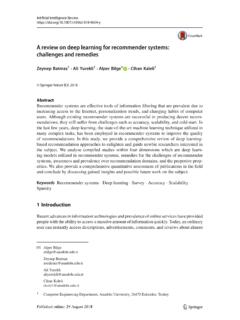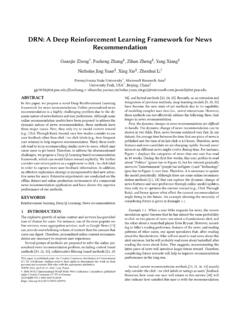Transcription of Towards the Next Generation of Recommender Systems: A ...
1 1 Towards the Next Generation of Recommender Systems: A Survey of the State-of-the-Art and Possible Extensions Gediminas Adomavicius1 and Alexander Tuzhilin2 Abstract The paper presents an overview of the field of Recommender systems and describes the current Generation of recommendation methods that are usually classified into the following three main categories: content-based, collaborative, and hybrid recommendation approaches. The paper also describes various limitations of current recommendation methods and discusses possible extensions that can improve recommendation capabilities and make Recommender systems applicable to an even broader range of applications. These extensions include, among others, improvement of understanding of users and items, incorporation of the contextual information into the recommendation process, support for multi-criteria ratings, and provision of more flexible and less intrusive types of recommendations.
2 Index Terms Recommender systems, collaborative filtering, rating estimation methods, extensions to Recommender systems. 1. Introduction Recommender systems became an important research area since the appearance of the first papers on collaborative filtering since the mid-1990s [45, 86, 97]. There has been much work done both in the industry and academia on developing new approaches to Recommender systems over the last decade. The interest in this area still remains high because it constitutes a problem-rich research area and because of the abundance of practical applications that help users to deal with information overload and provide personalized recommendations, content and services to them.
3 Examples of such applications include recommending books, CDs and other products at [61], movies by MovieLens [67], and news at VERSIFI Technologies (formerly ) [14]. Moreover, some of the vendors have incorporated recommendation capabilities into their commerce servers [78]. However, despite all these advances, the current Generation of Recommender systems still requires further improvements to make recommendation methods more effective and applicable to an even broader range of real-life applications, including recommending vacations, certain 1 G. Adomavicius is with the Carlson School of Management, University of Minnesota, 321 19th Avenue South, Minneapolis, MN 55455.
4 Email: 2 A. Tuzhilin is with the Stern School of Business, New York University, 44 West 4th Street, New York, NY 10012. Email: 2types of financial services to investors, and products to purchase in a store made by a smart shopping cart [106]. These improvements include better methods for representing user behavior and the information about the items to be recommended, more advanced recommendation modeling methods, incorporation of various contextual information into the recommendation process, utilization of multi-criteria ratings, development of less intrusive and more flexible recommendation methods that also rely on the measures that more effectively determine performance of Recommender systems.
5 In this paper, we describe various ways to extend capabilities of Recommender systems. However, before doing this, we first present a comprehensive survey of the state-of-the-art in Recommender systems in Section 2. Then we identify various limitations of the current Generation of recommendation methods and discuss some initial approaches to extending their capabilities in Section 3. 2. The Survey of Recommender Systems Although the roots of Recommender systems can be traced back to the extensive work in the cognitive science [87], approximation theory [81], information retrieval [89], forecasting theories [6], and also have links to management science [71], and also to the consumer choice modeling in marketing [60], Recommender systems emerged as an independent research area in the mid-1990 s when researchers started focusing on recommendation problems that explicitly rely on the ratings structure.
6 In its most common formulation, the recommendation problem is reduced to the problem of estimating ratings for the items that have not been seen by a user. Intuitively, this estimation is usually based on the ratings given by this user to other items and on some other information that will be formally described below. Once we can estimate ratings for the yet unrated items, we can recommend to the user the item(s) with the highest estimated rating(s). More formally, the recommendation problem can be formulated as follows. Let C be the 3set of all users and let S be the set of all possible items that can be recommended, such as books, movies, or restaurants. The space S of possible items can be very large, ranging in hundreds of thousands or even millions of items in some applications, such as recommending books or CDs.
7 Similarly, the user space can also be very large millions in some cases. Let u be a utility function that measures usefulness of item s to user c, , :uC S R , where R is a totally ordered set ( , non-negative integers or real numbers within a certain range). Then for each user cC , we want to choose such item sS that maximizes the user s utility. More formally: , argmax ( , )csScC sucs = (1) In Recommender systems the utility of an item is usually represented by a rating, which indicates how a particular user liked a particular item, , John Doe gave the movie Harry Potter the rating of 7 (out of 10).
8 However, as indicated earlier, in general utility can be an arbitrary function, including a profit function. Depending on the application, utility u can either be specified by the user, as is often done for the user-defined ratings, or is computed by the application, as can be the case for a profit-based utility function. Each element of the user space C can be defined with a profile that includes various user characteristics, such as age, gender, income, marital status, etc. In the simplest case, the profile can contain only a single (unique) element, such as User ID. Similarly, each element of the item space S is defined with a set of characteristics. For example, in a movie recommendation application, where S is a collection of movies, each movie can be represented not only by its ID, but also by its title, genre, director, year of release, leading actors, etc.
9 The central problem of Recommender systems lies in that utility u is usually not defined on the whole CS space, but only on some subset of it. This means u needs to be extrapolated to the whole space CS . In Recommender systems, utility is typically represented by ratings 4and is initially defined only on the items previously rated by the users. For example, in a movie recommendation application (such as the one at ), users initially rate some subset of movies that they have already seen. An example of a user-item rating matrix for a movie recommendation application is presented in Table 1, where ratings are specified on the scale of 1 to 5. The symbol for some of the ratings in Table 1 means that the users have not rated the corresponding movies.
10 Therefore, the recommendation engine should be able to estimate (predict) the ratings of the non-rated movie/user combinations and issue appropriate recommendations based on these predictions. K-PAX Life of Brian Memento Notorious Alice 4 3 2 4 Bob 4 5 5 Cindy 2 2 4 David 3 5 2 Table 1.


![Recommender Systems [Netflix] - DataJobs.com](/cache/preview/3/7/d/8/3/d/e/f/thumb-37d83def3c4723b94200221278349a79.jpg)